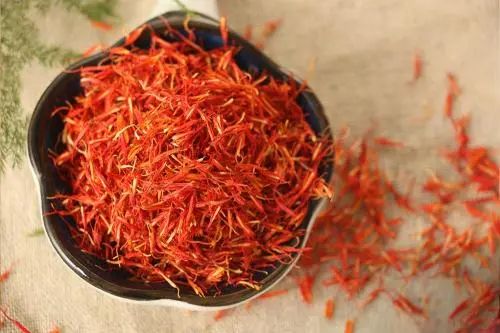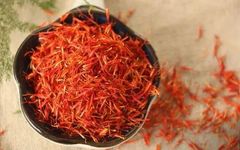————————————————————————————————————————————————————————————————–
 Also known as: Du Honghua (Safflower), Jin Honghua (Golden Safflower)
Also known as: Du Honghua (Safflower), Jin Honghua (Golden Safflower)
Taste and Properties: Pungent, warm; enters the Heart and Liver meridians.
King of Linoleic Acid
Clinically, Honghua (Safflower) is widely used and has excellent effects in activating blood and resolving stasis, as well as promoting menstruation. It is regarded as a key blood-activating herb across various medical disciplines. The “Wai Tai Mi Yao” states, “For all types of swelling, use Honghua, crush it to extract the juice and take it.” The “Jin Gui Yao Lue” also records, “For women suffering from sixty types of wind and abdominal pain due to blood and qi stagnation, use Honghua wine.” Modern research has found that the content of linoleic acid in Honghua is the highest among all known plants, hence it is also referred to as the “King of Linoleic Acid.”
Honghua Profile
Honghua, also known as Du Honghua, Huai Hong, Chuan Honghua, and Cao Honghua, is cultivated nationwide, primarily in Henan, Zhejiang, Jiangsu, Sichuan, and Xinjiang. It is an annual herbaceous plant of the Asteraceae family, with the medicinal part being the tubular flowers, which are harvested in summer when they turn red, removing the stems and leaves, and then dried in the shade or sun. Modern studies show that Honghua contains yellow pigments, safflower glycosides, palmitic acid, linoleic acid, oleic acid, arachidonic acid, polysaccharides, catechins, and new safflower glycosides. Additionally, “Honghua Zi” oil is derived from its fruit, “Bai Ping Zi.”
Efficacy and Indications:
Efficacy: Activates blood circulation, promotes menstruation, and alleviates minor pain.
Indications: 1. Used for amenorrhea, dysmenorrhea, abdominal pain due to retained placenta postpartum, lochia not flowing after childbirth, and stillbirth. 2. Used for symptoms of masses, contusions, and pain due to blood stasis. 3. Used for rashes with dark colors caused by heat and blood stagnation.
Identification of Authenticity:
Western saffron is a precious medicinal material with effects similar to Honghua but stronger, leading to instances of Honghua being mixed with Western saffron for sale. Honghua has tubular flowers, with the corolla being reddish-yellow or red, the corolla base being slender and five-lobed at the tip, with the lobes being linear and gathered into a tube. The stigma slightly protrudes from the anther tube, appearing as a long cylindrical shape with a slightly bifurcated tip. When soaked in water, it turns golden yellow. The complete stigma of Western saffron is linear, with a wider tip that tapers downwards, having irregular serrated edges, and the lower end retains yellow flower columns that are purplish-red or dark brown with a slight sheen. When dried, it becomes brittle and breaks easily; when the stigma is placed in water, it swells and dyes the water yellow, with a slight stimulating odor.
Precautions:
1. Pregnant women should use with caution as it may induce miscarriage. 2. Reports indicate that some patients taking Honghua may experience nosebleeds, ataxia, prolonged or early menstruation, drowsiness, lethargy, dry mouth, pink urine, or allergic reactions.
Medicinal Diet for Health:
1. Nourishing blood, activating blood, regulating menstruation.
Honghua Glutinous Rice Porridge: 10g of Honghua, 10g of Danggui (Angelica Sinensis), 15g of Danshen (Salvia Miltiorrhiza), decoct in water, filter to retain the juice, add an appropriate amount of glutinous rice to cook porridge, and divide into two servings. Suitable for those with irregular menstruation.
2. Tonifying qi and nourishing blood.
Black Bean and Honghua Soup: 100g of black beans, soaked in water, simmered until soft, then add 5g of Honghua and an appropriate amount of brown sugar, and simmer slightly. Suitable for those with amenorrhea due to blood deficiency and qi stagnation.
3. Promoting qi, activating blood, resolving phlegm, and softening hardness.
Honghua, Tangerine Peel, and Seaweed Soup: 9g of Honghua, 45g of tangerine peel, 9g of seaweed, decoct for 15 minutes, season, and consume. Suitable for treating hyperthyroidism.
Ancient and Modern Recipes:
1. For treating chronic hepatitis.
6g of apricot kernels, 6g of Honghua, 6g of chrysanthemum, first boil with high heat, then simmer for 10 minutes, and add an appropriate amount of white sugar. Suitable for chronic hepatitis patients.
2. For treating frostbite.
9g of cinnamon twig, 9g of Honghua, 9g of Dangshen (Codonopsis), 15g of Huangqi (Astragalus), 9g of dried ginger, 9g of Danshen, 9g of tangerine peel, 9g of peach kernel, and 9g of Danggui, decoct for oral administration. Suitable for frostbite patients.
3. For treating vitiligo of the vulva.
6g of Honghua, 9g of Bu Guo Zi (Psoralea), 9g of Amaranth Seed, 6g of Jang Can (Silkworm), 9g of Bai Ji Li (Tribulus), soaked in 120ml of white wine for 7 days, and applied externally to the affected area 1-2 times daily.
4. For treating hyperlipidemia.
5g of Honghua and 5g of green tea, steeped in boiling water, consumed as tea. Suitable for patients with hyperlipidemia.
5. For treating irregular menstruation and dysmenorrhea.
30g of Danggui, 20g of Honghua, 15g of Danshen, 15g of rose petals, ground into powder, wrapped in gauze, and soaked in 1500ml of rice wine for 7 days.
Blood-activating and stasis-resolving herbs are a class of medicines primarily used to promote blood circulation, enhance blood flow, and dissipate blood stasis, commonly referred to as blood-activating herbs. This includes Honghua, Chuanxiong (Ligusticum), Yujin (Curcuma), Yimucao (Leonurus), Wangbuliuxing (Vaccaria), rose petals, pangolin, and leeches. The causes of blood stasis are numerous, such as qi stagnation, blood stasis due to qi stagnation, cold coagulation, wind-damp obstruction, and meridian blockage. If patients present with chest, abdominal, or headache pain that feels like a needle prick, with fixed pain; or hemiplegia and numbness after a stroke; or chronic rheumatic joint pain; or internal bleeding with purple-dark blood clots; or external injuries with swelling and pain from fractures, blood-activating and stasis-resolving herbs can be applied, adjusting according to symptoms, addressing both the root and branch. Historically, physicians have believed that “qi is the commander of blood,” “qi stagnation leads to blood stagnation,” and “qi movement leads to blood movement,” thus in clinical practice, blood-activating and stasis-resolving herbs are often used in combination with qi-regulating herbs to enhance their blood-activating effects. Additionally, it should be noted that blood-activating herbs can easily consume blood and cause disturbances, so they should be used cautiously in pregnant women, avoided by women with excessive menstruation, and not used in cases of no blood stasis.

The knowledge left by our ancestors is often simple yet practical!
If you find it useful, save it for future reference and share it with your friends, as it can truly help everyone!
Disclaimer: This article is reproduced from the internet and published materials. If there is any infringement, please contact us for removal. The various prescriptions and recipes mentioned are for informational sharing only and do not constitute medical advice, recommendations, or guidance. Please use them under the guidance of a physician.

